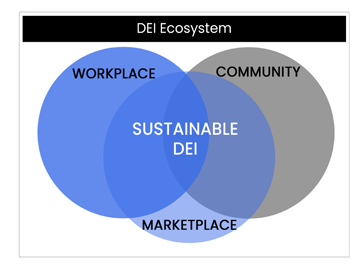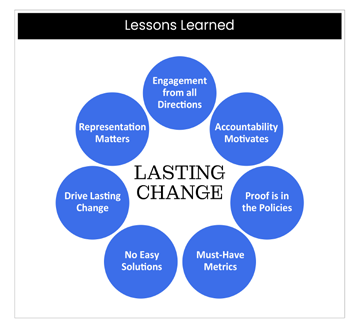As a proud member of the Association of Executive Search and Leadership Consultants (AESC), we're delighted to share their latest report on Diversity, Equity (or Equality) and Inclusion (DEI), which focuses on how organisations can utilise DEI strategies to create a competitive advantage.
We've extracted the key aspects below but you can download a full copy of the report here.
1. Background
The AESC report has been developed through their Diversity Councils and includes 52 client interviews from around the world, complemented with a survey of over 1300 business leaders around the world, with over one third being CEOs.
The report presents DEI as a journey that includes eight steps toward sustainable change, moves through a DEI ecosystem and identifies key lessons learned through the client interviews.
2. Top 3 Highest Impact DEI Strategies
In the context of culture, leaders were asked to identify the highest impact DEI strategies in their organisations. The top three strategies that were subsequently recognised as being the most critical to success are:
- Foster a safe and inclusive environment
- Communicate the importance of Diversity, Equality, and Inclusion
- Leadership is publicly committed
3. The DEI Change Model
The ultimate aim of individuals dedicated to diversity, equality, inclusion, and belonging is to foster enduring transformation - constructing a globally accessible world that embraces diversity, equality, and an unwavering sense of belonging for everyone.
The pursuit of long-lasting DEI change involves a dynamic journey filled with challenges, triumphs, and the chance to commemorate achievements, all rooted in a deep respect for every individual and driven by positive progress for all.
 The learnings on embedding sustainable DEI were taken from client interviews and applied using the 8-step framework from the work of the foremost expert on leading change, John Kotter.
The learnings on embedding sustainable DEI were taken from client interviews and applied using the 8-step framework from the work of the foremost expert on leading change, John Kotter.
The model comprises of 3 key stages, starting with ensuring an organisation has created a climate for change. Without that initial commitment for establishing the right change environment, embedding DEI will be a much more challenging process.
By having the right change environment, an organisation can then engage and deliver the change, ultimately leading to sustainability and lasting DEI change.
4. The DEI Ecosystem
As we seek to understand change, it's essential to keep in mind that it doesn't happen in a vacuum.
 Change takes place within an ecosystem, and this is especially true within a business organisation. Internally, a business has a network of teams, leaders, and a unique culture that shapes its operations. But it doesn't end there.
Change takes place within an ecosystem, and this is especially true within a business organisation. Internally, a business has a network of teams, leaders, and a unique culture that shapes its operations. But it doesn't end there.
The business interacts with employees, customers, suppliers, and communities. It operates within an industry and interrelates with regulatory environments. The DEI ecosystem, in particular, plays an influential role in the ability to achieve sustainable change.
The change leaders spoken to as part of the research are focused on shaping, influencing, and leading their internal and external environments towards greater fairness, inclusion, and belonging – not just for themselves, but for everyone involved.
5. The Importance of Leadership for DEI Change
As we've already seen, a publicly committed leadership team is one of the top three strategies and is essential for successful DEI change. So what does this mean in practice?
There is no definitive list but there are some clear steps that have shone through from the client interviews as being critical for their DEI journeys.
- Public Commitment - a common first step was an initial commitment by their boards and CEOs which was publicly announced and had an accompanying accountability element to it. So there were set targets and business owners to motivate, communicate and be responsible for the delivery of the commitment.
- Overcoming Barriers - with any change, one thing becomes apparent: challenges are inevitable. Frequently, these challenges extend beyond companies' immediate influence and reside in the regulatory environment and the biases that are ingrained in external culture. One of the most commonly cited challenges is the absence of adequate metrics. It is incumbent upon the leadership of the organisation to address these challenges through implementing benchmarking, goal setting, and reporting. For those who are resist inclusion or who hold biases, leaders must address those obstacles through training, accountability, and mentoring. Ultimately, the path to change may be challenging, but it's worth it to achieve equality, inclusion, and belonging.
- Employee Policies - identifying and implementing policies that help to address some of the inequalities that can occur due to unconscious bias can be vital. For example, talent from unrepresented groups can gain significant benefit from mentorship and sponsorship opportunities whilst a dedicated policy aimed at re-entry support for women returning to the workforce can help mitigate career disruption for caregivers.
- Workforce Representation - this is a vital component of DEI change on every level - from the very bottom rung of an organisation to the very top at Board level.
If you don’t have representation, nothing else matters because it starts there. If you can’t see someone like yourself on the executive team, then you will doubt if the company really believes in diversity, equity and inclusion.”
– Global Tech CEO
Every organisation should have a workforce that is fully reflective of the customers and communities they serve in addition to their overall society. Initiatives such as establishing diverse hiring committees, requiring representation on interview panels, and instituting pay equality audits and corrective measures will all help increase the level of DEI across an organisation.
6. The Lessons Learned
In the pursuit of DEI, the ultimate aspiration is to foster an environment where every individual is not only respected but also deeply valued. Such an inclusive setting allows everyone to truly belong, embracing their unique identities and contributions. To achieve it isn't always going to be easy and mistakes will be made and lessons learned, including some key themes below from an analysis of the client interviews.

Summary
Within an organisation, this commitment to DEI propels a competitive advantage, as it becomes a magnet for exceptional talent across all levels. Furthermore, this approach enables the retention of that talent by offering ample opportunities for growth and unleashing their full potential. The benefits of this approach are far-reaching, as it fuels innovation, drives growth, and fuels overall success.
Most importantly, genuine dedication to DEI has the power to amplify these positive impacts beyond the organisation, resonating throughout the broader DEI ecosystem. By striving for DEI excellence, individuals are empowered, communities are uplifted, and ultimately, society moves closer to a future where DEI is the norm.
About AESC
Since 1959, AESC has set the quality standard for the executive search and leadership consulting profession. AESC Members represent 16,000+ trusted professionals in 1,200+ offices, spanning 70+ countries. AESC Members are recognised experts providing consulting services in the areas of leaders, teams, and culture to the world’s leading organisations. They leverage their access and expertise to place more than 100,000 executives each year in board of directors and C-level positions across industry sectors.
Dedicated to strengthening leadership together, AESC and its members share a deep commitment to the highest quality standards in executive search and leadership consulting—for the benefit of clients, candidates, and the profession. Our Code of Conduct has long included a commitment to Diversity and Inclusion and as an AESC member, Executive Headhunters are fully committed to this code.
About Executive Headhunters
As an International Executive Search firm, we are experts at identifying and attracting high-calibre senior executives to fill challenging and business critical vacancies. We are one of only 0.1% of UK recruitment companies who are a fully-accredited member of the AESC.
We understand that no two businesses are the same, which is why we start every assignment with a blank canvas. We undertake a thorough and methodical research process that is bespoke to your business and your industry. Our rigorous methodology is specifically designed to encourage diversity, equality and inclusion at every stage of the recruitment process.
We don’t have a database of candidates that we search through, so we identify and approach every suitable candidate for the specific role we are headhunting for.
We have extensive experience recruiting for businesses of all sizes and across all sectors. In addition, we have a global reach that ensures we can expertly deliver international assignments, as well as having access to a global pool of candidates that are suitable for UK roles.


